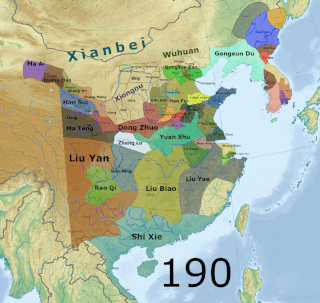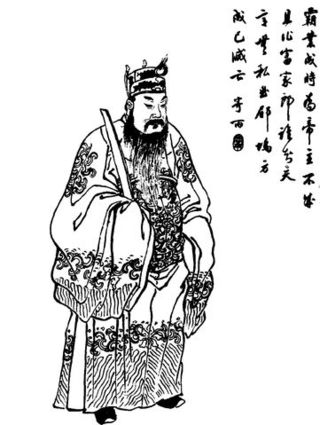
The 2nd century is the period from AD 101 through AD 200 (CC) in accordance with the Julian calendar. It is considered part of the Classical era, epoch, or historical period.
The 160s decade ran from January 1, 160, to December 31, 169.
The 180s decade ran from January 1, 180, to December 31, 189.

The Three Kingdoms of Cao Wei, Shu Han, and Eastern Wu dominated China from 220 to 280 AD following the end of the Han dynasty. This period was preceded by the Eastern Han dynasty and followed by the Western Jin dynasty. Academically, the periodisation begins with the establishment of Cao Wei in 220 and ends with the conquest of Wu by Jin in 280. The period immediately preceding the Three Kingdoms, from 184 to 220, was marked by chaotic infighting among warlords across China as Han authority collapsed. The period from 220 to 263 was marked by a comparatively stable arrangement between Cao Wei, Shu Han, and Eastern Wu. This stability broke down with the conquest of Shu by Wei in 263, followed by the usurpation of Cao Wei by Jin in 266 and ultimately the conquest of Wu by Jin in 280.

The Yellow Turban Rebellion, alternatively translated as the Yellow Scarves Rebellion, was a peasant revolt during the late Eastern Han dynasty of ancient China. The uprising broke out in 184 CE, during the reign of Emperor Ling. Although the main rebellion was suppressed by 185 CE, it took 21 years for full suppression of resistant areas and emerging rebellions by 205 CE. The weakening of the imperial court and the rising political influence of ultra-autonomous regional military-governors, who helped suppress the rebellion, eventually led to rampant warlord dominance and the resultant Three Kingdoms period.
Emperor Ling of Han, personal name Liu Hong, was the 12th emperor of the Eastern Han dynasty. He was also the last Eastern Han emperor to exercise effective power during his reign. Born the son of a lesser marquis who descended directly from Emperor Zhang, Liu Hong was chosen to be emperor in February 168 around age 12 after the death of his predecessor, Emperor Huan, who had no son to succeed him. He reigned for about 21 years until his death in May 189.

Dong Zhuo, courtesy name Zhongying, was a Chinese military general, politician, and warlord who lived in the late Eastern Han dynasty. At the end of the reign of the Eastern Han, Dong Zhuo was a general and powerful minister of the imperial government. Originally from Liang Province, Dong Zhuo seized control of the imperial capital Luoyang in 189 when it entered a state of turmoil following the death of Emperor Ling of Han and a massacre of the eunuch faction by the court officials led by General-in-Chief He Jin.

Zhang Jue was a Chinese military general and rebel. He was the leader of the Yellow Turban Rebellion during the late Eastern Han dynasty of China. He was said to be a follower of Taoism and a sorcerer. His name is sometimes read as Zhang Jiao, since the Chinese character of Zhang's given name can be read as either "Jiao" or "Jue". "Jue" is the traditional or literary reading, while "Jiao" is the modern or colloquial one.

The military history of the Three Kingdoms period encompasses roughly a century's worth of prolonged warfare and disorder in Chinese history. After the assassination of General-in-chief He Jin in September 189, the administrative structures of the Han government became increasingly irrelevant. By the time of death of Cao Cao, the most successful warlord of North China, in 220, the Han empire was divided between the three rival states of Cao Wei, Shu Han and Eastern Wu. Due to the ensuing turmoil, the competing powers of the Three Kingdoms era found no shortage of willing recruits for their armies, although press-ganging as well as forcible enlistment of prisoners from defeated armies still occurred. Following four centuries of rule under the Han dynasty, the Three Kingdoms brought about a new era of conflict in China that shifted institutions in favor of a more permanent and selective system of military recruitment. This ultimately included the creation of a hereditary military class as well as increasing reliance on non-Chinese cavalry forces and the end of universal conscription.

The end of the Han dynasty was the period of Chinese history from 189 to 220 CE, roughly coinciding with the tumultuous reign of the Han dynasty's last ruler, Emperor Xian. It was followed by the Three Kingdoms era. During the end of the Han dynasty, the country was thrown into turmoil by the Yellow Turban Rebellion (184–205). Meanwhile, the Han Empire's institutions were destroyed by the warlord Dong Zhuo and fractured into regional regimes ruled by various warlords, some of whom were nobles and officials of the Han imperial court. The warlord Cao Cao took control of Emperor Xian and his court in 196 and began gradually reunifying the empire. Cao Cao ostensibly operated under Emperor Xian's rule, though in reality the emperor was a hostage.
Huangfu Song, courtesy name Yizhen, was a military general who lived during the Eastern Han dynasty of China. He is best known for helping to suppress the Yellow Turban Rebellion and Liang Province Rebellion. He was one of three imperial commanders when the Yellow Turban Rebellion broke out, along with Zhu Jun and Lu Zhi. He was known to be a modest and generous person. Lu Zhi was removed from command after the eunuch Zuo Feng (左豐) made false accusations against him; Lu Zhi had refused to bribe Zuo Feng. Huangfu Song, who took over command of the imperial troops from Lu Zhi, continued to use Lu as a strategist and reported his contributions to the imperial court. Thus, in the same year, Lu Zhi regained his post as Master of Writing (尚书).
Liu Yan, courtesy name Junlang, was a Chinese politician and warlord who lived in the late Eastern Han dynasty of China. He was also a member of the extended family of the Han emperors. For most of his career he served as the governor of Yi Province, which he developed into an independent power base. His domain was passed on to his son Liu Zhang, and eventually to Liu Bei, who founded the state of Shu Han during the Three Kingdoms period.

Taipingjing is the name of several different Taoist texts. At least two works were known by this title:
Zhang Wen, courtesy name Boshen, was a Chinese official and military general of the Eastern Han dynasty. Zhang held prime ministerial office during the reign of Emperor Ling of Han, serving as Grand Excellency of Works from 184 to 185 and Grand Commandant from 186 to 187. Zhang oversaw the dynasty's military response to the Liang Province Rebellion from 185 to 186, supervising the future warlords Dong Zhuo and Sun Jian. After Dong seized control of the Eastern Han court in 189 and relocated it from Luoyang to Chang'an, Zhang continued to serve in ministerial office while conspiring against Dong. He was executed in November 191 at Dong's order.

The Han dynasty was the second imperial dynasty of China. It followed the Qin dynasty, which had unified the Warring States of China by conquest. It was founded by Liu Bang. The dynasty is divided into two periods: the Western Han and the Eastern Han (25–220 CE), interrupted briefly by the Xin dynasty (9–23 CE) of Wang Mang. These appellations are derived from the locations of the capital cities Chang'an and Luoyang, respectively. The third and final capital of the dynasty was Xuchang, where the court moved in 196 CE during a period of political turmoil and civil war.
The Liang Province rebellion from 184 to 189 started as an insurrection of the Qiang peoples against the Han dynasty in the western province of Liang in the second century AD in China, but the Lesser Yuezhi and sympathetic Han rebels soon joined the cause to wrestle control of the province away from central authority. This rebellion, which closely followed the Yellow Turban Rebellion, was part of a series of disturbances that led to the decline and ultimate downfall of the Han dynasty. Despite receiving relatively little attention in the hands of traditional historians, the rebellion nonetheless had lasting importance as it weakened Han Chinese power in the northwest and prepared that land for a number of non-Han-ruled states in the centuries to come.
The Way of the Taiping, also known as the Way of the Great Peace, was a Chinese Taoist movement founded by Zhang Jue during the Eastern Han dynasty. Its adherents all around China participated in the Yellow Turban Rebellion of 184, with the rebellion being suppressed within the same year by the Eastern Han government. The religious movement was greatly reduced and died soon afterwards. The Way of the Taiping was one of the two largest movements within early Taoism, with the other being the Way of the Five Pecks of Rice. During the reign of Emperor Ling of Han, the movement was recorded to have been popular in eight Provinces: Qing Province, Xu Province, You Province, Ji Province, Jing Province, Yang Province, Yan Province, and Yu Province.。
The Yellow Turban Army, also known as the Yellow Turban Bandits, was a peasant rebel force led by the late Eastern Han dynasty mystic Zhang Jue from Julu Commandery. The Yellow Turbans launched an uprising against the central government in 184, the year of the Jiazi in the Sexagenary cycle. The Yellow Turban Rebellion became one of the biggest rebellions in Chinese history, but it was mostly quelled within a year by the Eastern Han government. As result, the Chinese historiography has always placed it as the progenitor of the Three Kingdoms Era. Some Yellow Turban factions continued their insurgency for decades, however, and the last known remnants of the movement were defeated in the first decade of the 3rd century.
Ma Xiang was a self-declared Emperor of China, Yellow Turban rebel, warlord, and bandit leader who lived in the late 2nd century. Although operating after the main Yellow Turban Rebellion had been defeated, Ma proved highly successful in leading a large insurgency in the western Han Empire of China. At the peak of his power, he controlled most of the northern Yi Province before being defeated and killed by Han loyalist Jia Long.







